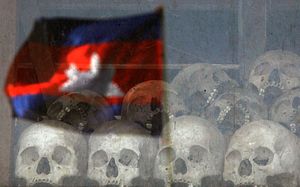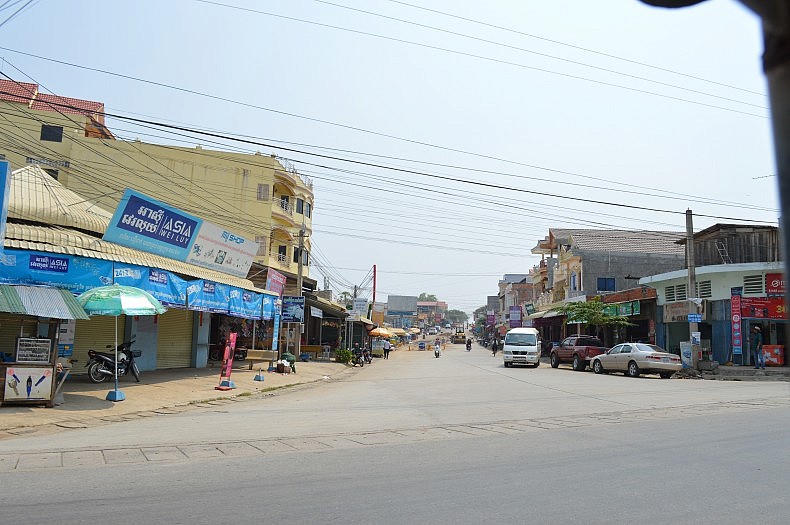PAILIN, Cambodia – Sou San is a small, cheerful man. He is not one to turn down a beer in the company of friends, and his soft spoken, outgoing personality fits well with his job: He is an official in the tourism department of Pailin, a northern province of Cambodia and the last Khmer Rouge stronghold.
The 60-year-old moved to the sleepy little border town in 1979, and that was no coincidence. Four years earlier, Pol Pot and his ultra-nationalist political movement, the Khmer Rouge, began a social experiment of creating a classless communistic utopia, by dividing the entire country into zones and regions and forcibly transferring over two million people to live and work in them.
It went horribly wrong. An estimated 1.7 million people died during one of the worst genocides of the 20th century.
Sou San became a cadre in 1972, a few years before the Khmer Rouge rose to power. All his family members were part of the Khmer Rouge, and when Sou San was 16 years old, he decided to join too. He was in charge of the production of rice, and also worked as an assistant for the district governor.
“I would do anything they told me,” he told The Diplomat. “Any order given at any time, even at midnight, I would do it. Mostly what they told me was to deliver messages and letters from one place to another, so I did that. I had a horse.”
Those days when Pol Pot led the country were happy days, he says.
But that’s a very selective truth, says Youk Chhang, the executive director of the Documentation Center of Cambodia (DC-Cam), the world’s largest repository of information about the Cambodian genocide — and a Khmer Rouge survivor himself.
Chhang lived in another region during the reign of the Khmer Rouge and tells a more familiar story about their brutal reign.
“Most of us were sent there from the city to experience the hardship of the revolution, and we were treated horribly. We were tortured, starved, and killed,” he says.
In fact, due to Khmer Rouge-imposed restrictions of food as well as seemingly endless and grueling labor, most of the country experienced famine during the late 1970s, the worst in Cambodia’s history. Hundreds of thousands of people nationwide succumbed to starvation and exhaustion.
When Vietnamese troops entered Cambodia in 1979, they were met by a frail, disorganized regime, which they toppled easily.
The Khmer Rouge leadership, weakened but far from defeated, fled to the Thai border in the north, regrouped and took control of the northern border area. In the chaotic aftermath of regime change, soldiers, commanders, supporters, and party members from all over the country also made their way up to the north.
Elsewhere, both in Cambodia and internationally, there were reports of mass killings, torture, starvation and executions – though not so in the north, insists Sou San. In 1979 he moved to Pailin, and in the coming years, he remained loyal to the Khmer Rouge.
“I met Pol Pot in 1987, when I was promoted to commander of a special unit. He requested a meeting with our unit, and he talked to us about how he wanted to create a society where nobody can oppress us,” Sou San recalls.
An experienced soldier at this point, he and his unit would patrol the border area and engage in fighting with any enemies they met. It was the right thing to do, Sou San argues.
“Pol Pot always defended the country. He was a nationalist. A patriot,” he says.
That sense of patriotic duty is also what prompted another former cadre, Tuouch, to join the Khmer Rouge.
“I did not think of the past when I joined. I wanted to protect the country against the Vietnamese,” says Tuouch, who now works as a border police chief.
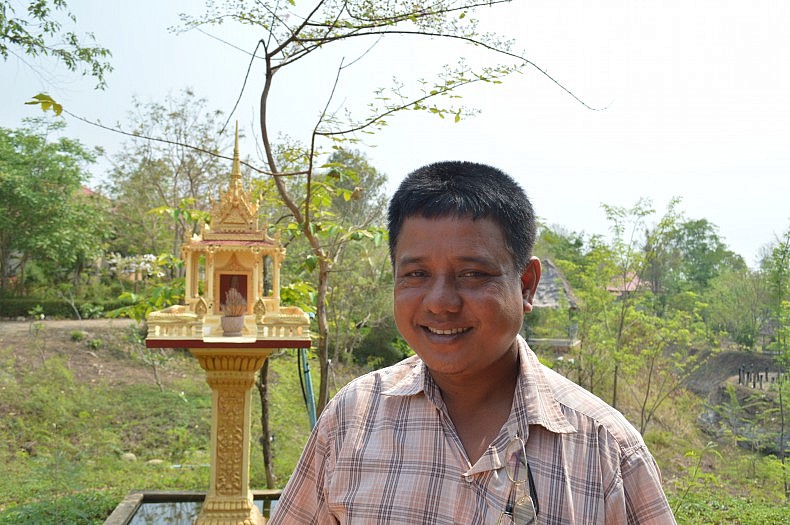
Tuouch, who joined the Khmer Rouge in 1981 and is now a district police chief. Photo Credit: Anya Palm
When he remembers his time as a soldier, he speaks of two different Khmer Rouges – the “bad” one, which inflicted the genocide upon its population, and the “good” one, from 1979 onward, who protected the country. He himself joined in 1981.
“From 1981 the Khmer Rouge was a good influence on the country because we treated the population well and they had enough food to eat,” he says.
He lived in jungle, with the other guerrilla soldiers and fought two enemies – the Vietnamese as well as the government troops. The latter were sent out by the new government, installed by Vietnam and led by a young Khmer Rouge defector Hun Sen, who continues to rule Cambodia more than three decades later.
The Hun Sen government’s attempts to weed out the guerrilla fighters were unsuccessful, and the war dragged on. It didn’t help that the West – then spooked by American defeat and withdrawal from the Vietnam War – refused to recognize the new Vietnamese-backed government and instead supported a de facto government that also included the Khmer Rouge.
Finally, in 1996, in exchange for the guerrillas laying down their arms, the top leaders were awarded amnesty for their past actions. A plot of land was carved out to be a separate administrative division for them to govern, placing the amnestied leadership in charge of the city of Pailin.
Today about half of the 70,000 people living in Pailin are former Khmer Rouge cadres, many of whom hold government positions just like Sou San and Tuouch.
Here in Pailin, it is difficult to have a candid conversation about the mass killings of the past. Top officials, including former president Khieu Samphan and ex-foreign minister Ieng Sary, are respected rather than reviled. Khmer Rouge loyalists maintain that they were unaware of any atrocities committed.
Sou San says he was uninformed and is today “regretful we did not have information to make a decision.”
“I believe the leaders made mistakes,” he offers. “But I still support the Khmer Rouge.”
At least one of the very top leaders did know that there were mass killings going on, says Nuon Sann, a Khmer Rouge soldier turned large-scale cassava farmer and the godson of Nuon Chea, the second-in-command to Pol Pot who is on trial at the Khmer Rouge Tribunal in Phnom Penh for crimes against humanity alongside Khieu Samphan.
He and his godfather, who was commonly known as “Brother Number Two,” have discussed what went wrong under the Khmer Rouge. In their view, the mass killings were a product of an overreaction by poor peasants and farmers rather than a deliberate policy, despite historical evidence to the contrary.
“When the Khmer Rouge came, the farmers and the peasants joined, and they were very angry. They were promoted within the Khmer Rouge to commanders or leaders of their own units, and then they took revenge. They executed the rich,” he says.
He defends his godfather Nuon Chea as a “good person” who is “sorry” about the mass killings.
“Nuon Chea loved the peasants too much. But they were full of anger,” he says.
This paternal love for misbehaving farmers is not anywhere near historical fact, says Youk Chhang, the director of the documentation center DC-Cam. Nor is there such a thing as a “good” Khmer Rouge, as police chief Tuouch argues. Not in the 1970s, and not since.
“Whatever happened before the war, during the war, or after the war, the Khmer Rouge has not changed at all. They will do anything to convince people that they were nice, but they remain the same,” he says.
He does not believe the argument that the Khmer Rouge leaders were unaware of what was happening in the country.
“The mass graves are no secret. The prisons are no secret. The evidence is in every single commune, every single city, every single province,” he says. “How can you miss 20,000 mass graves nationwide in Cambodia? They are right there, in front of your face.”
Along the dusty but paved road that constitutes almost the entire city of Pailin are several blue signs with pictures of three men on them. One of them is Hun Sen, the young Vietnamese-backed defector, who managed to muscle his way into the prime minister’s office and stay there. They are also party signs for the ruling Cambodian People’s Party (CPP), which dominates Pailin politics.
But there are pockets of opposition too. In the local office of the Cambodian National Rescue Party (CNRP), a key opposition party nationwide, Ven Ra and her husband are working for a cause: a Cambodia with full rights, freedom, and democracy, as she puts it.
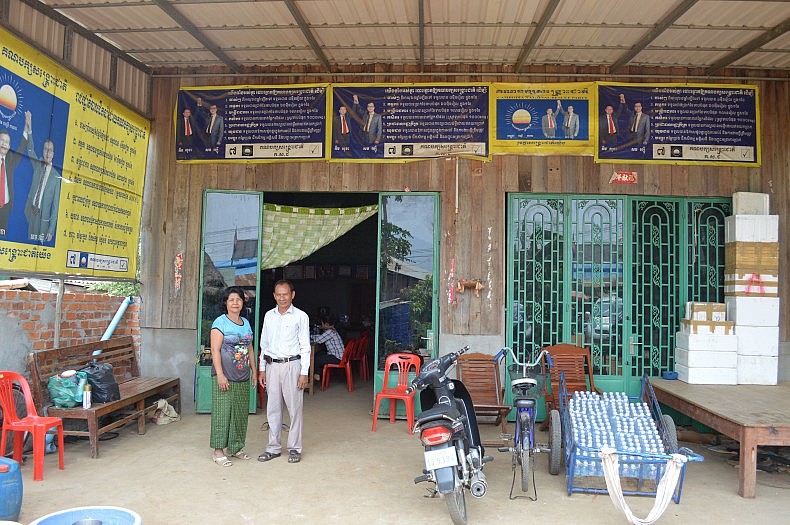
Ven Ra and her husband Kinh Ponh in front of the party headquarters of the opposition CNRP in Pailin. Photo Credit: Anya Palm
Ven Ra is head of the local CNRP. Should they win next election, she could assume office as governor of Pailin.
But like most of Pailin’s residents, both are former Khmer Rouge soldiers who are unapologetic about their pasts even as they work for a better future for Cambodia.
“Our target was not to kill people. Our target was to rebuild Cambodia as a new country,” Ven Ra’s husband Kinh Pon explains while she nods in agreement.
“But during the implementation of policies, for example the cleaning policy, some educated people were executed,” he admits in one candid moment. But it quickly becomes clear that he is unapologetic about that, too.
“Normally in a communist state it is not wrong to execute people,” he says bluntly.
The two of them follow the proceedings of the Khmer Rouge tribunal in Phnom Penh. The court is currently hearing testimonies against Nuon Chea and Khieu Samphan for genocide after the pair were convicted of crimes against humanity back in 2014.
Ven Ra disagrees with the tribunal’s scope. “They only prosecute the people who lost the internal war in the Khmer Rouge,” she says.
The former Khmer Rouge leadership had split into two feuding groups by the 1990s, she explained. While the losers are currently facing international prosecution for their crimes, the winners run the country and can be found on those blue party signs along the road.
“The leadership of the CPP are mostly former Khmer Rouge. What about them?” she says.
Hun Sen is the most glaring case. He joined the Khmer Rouge in 1970 but defected and fled to Vietnam in 1977 before returning to rule the country with Vietnamese support thereafter.
Reliable documentation from that period is limited, so the precise details of Hun Sen’s defection remain disputed. When he resurfaced in 1979, he was appointed foreign minister and deputy prime minister and took office.
These testimonies from Pailin are neither surprising nor new, says Youk Chhang. They represent one interpretation of Cambodia’s bloody political history as the nation continues to try to come to terms with its past.
“There are two versions of history, depending on who you talk to in Cambodia. If you talk to the other side, they will tell you differently,” he says.
The country did not start to teach Khmer Rouge history in schools until 2009. High school students today, he says, know their history better than the police chief, politician, and tourist official from Pailin.
“If you speak to high school students, they have proper textbooks and internet, and they can compare with genocides in other places in the world. They will have a more truthful version to offer,” he argues.
The school yard of Hun Sen Krongtepnimith Pailin High School is lush and green. Youngsters on their motorbikes chase after each other with open bottles of water, ready to splash anyone they can catch.
Under a tree sits 17-year-old Rhoul, who attends 11th grade. His sense of who the Khmer Rouge were is more closely aligned with the traditional historical accounts from the period.
“They have made Cambodia suffer, and have made families lose their family members. The kids could not go to school, and the country lost millions of people during the Khmer Rouge. They have made our development slower and left a number of orphans and handicapped people,” he says.
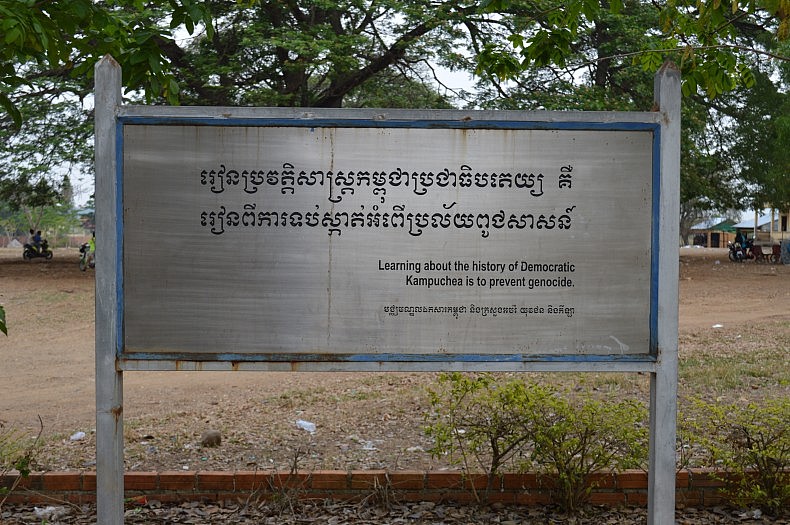
A sign from the Ministry of Education about genocide at Hun Sen Krongtepnimith Pailin High School. Photo Credit: Anya Palm.
But as he ventures into the contemporary era of Cambodian politics, it becomes clear that what is being taught about the Khmer Rouge in schools is still quite selective.
“Prime Minister Hun Sen was not a part of the Khmer Rouge,” he suggests. “He was the one who liberated the country.”













